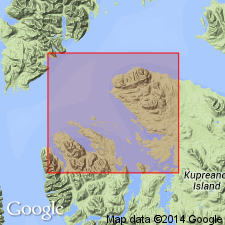
- Usage in publication:
-
- Cornwallis Limestone*
- Modifications:
-
- Named
- Biostratigraphic dating
- Dominant lithology:
-
- Limestone
- AAPG geologic province:
-
- Alaska Southeastern region
Summary:
[Named after Point Cornwallis]. Type location: northwest shore of Kuiu Island 0.75-2 mi ease-southeast of Point Cornwallis. Part of Hyd Group. Medium to very thick bedded medium gray oolitic limestone. At least 200 ft thick on northern part of Cornwallis Peninsula, possibly thicker to southeast. Oolite weathers medium brown with thin interbeds of dark aphanitic limestone and calcarenite. For most of outcrop area conformably overlies Keku Volcanics; contact placed at top of highest volcanic rock or conglomerate composed primarily of volcanic debris. At northwest tip of peninsula inferred to disconformably overlies Pybus Formation; contact not exposed due to faulting but lowest beds contain clasts from Pybus Formation. Overlain by Hound Island Volcanics in Kadak Bay area. Contains late Karnian to earliest Norian fossils (HALOBIA); age is Late Triassic. Coeval with Hamilton Island limestone and interpreted to be shallow water facies equivalent of deeper-water Hamilton Island limestone.
Source: GNU records (USGS DDS-6; Menlo GNULEX).
For more information, please contact Nancy Stamm, Geologic Names Committee Secretary.
Asterisk (*) indicates published by U.S. Geological Survey authors.
"No current usage" (†) implies that a name has been abandoned or has fallen into disuse. Former usage and, if known, replacement name given in parentheses ( ).
Slash (/) indicates name conflicts with nomenclatural guidelines (CSN, 1933; ACSN, 1961, 1970; NACSN, 1983, 2005, 2021). May be explained within brackets ([ ]).

